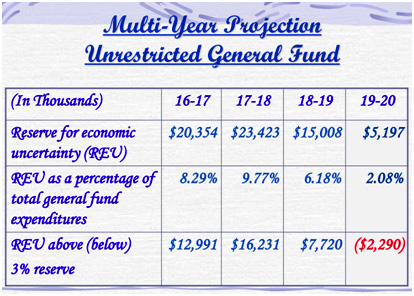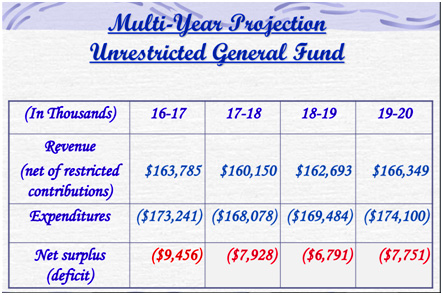TUSD at Risk of Not Meeting Future Financial Obligations
A recent financial report submitted to the California Department of Education (CDE) by TUSD received a qualified certification indicating that the district may not meet its future financial obligations. The CDE requires that school districts file bi-annual reports on the status of their financial health. These reports are certified as either positive, qualified, or negative. A qualified certification is assigned when a district may not meet its financial obligations for the current or two subsequent fiscal years.
TUSD’s current budget, approved last Monday, forecasts that the District will continue running large deficits over the next several years. In the current year, TUSD ran a $9.5 Million deficit. The projected deficit amount over the next three years is a hefty $22.5 Million.
The deficit spending is putting a huge dent in what was once a very healthy reserve. As recently as Fiscal Year 2013-14 the District had a budgeted $46.1 Million in reserves. The forecast now indicates the reserve will plummet to only $5.2 Million by FY 2019-20. That figure is $2.3 Million below the state mandated minimum.
Just prior to his retirement last year, former Deputy Superintendent Dr. Stabler explained that the District was intentionally spending down the reserve at the behest of the School Board. Alluding to why the Board took such action he said, “It’s the unions that don’t want us to have a reserve because they want to spend the money on salary increases.”
 TUSD’s approved budget also included 29 financial indicators that were reviewed to determine fiscal health. Of those 29, 12 were marked as potential areas of concern for fiscal solvency purposes that should be carefully reviewed. Among those areas of concern were:
TUSD’s approved budget also included 29 financial indicators that were reviewed to determine fiscal health. Of those 29, 12 were marked as potential areas of concern for fiscal solvency purposes that should be carefully reviewed. Among those areas of concern were:
- Salaries and Benefits;
- Available Reserves;
- Long-Term Debt Commitments;
- Post Employment Benefits Other than Pensions;
- Status of Labor Agreements; and
- Declining Enrollment
During the budget hearing, Board member Michael Wermers commented that the District had never done a qualified budget before. Wermers also noted that other local districts were not facing similar financial challenges and asked whether the District was being overly conservative in its estimates or if things would really get a little hairy in the next couple of years.
In response, superintendent Dr. Mannon attributed the budget challenges to major issues in the state with regard to pension contributions and increases in special education costs. He also insinuated that other Districts not projecting similar challenges to TUSD were either lucky or they were lying.
There are 1025 school districts in California. TUSD is one of 43 districts that received either a qualified or negative certification in CDE’s most recent report. The distinction puts TUSD among a grouping of only 4% of the districts in the state that received the worrisome qualified certification.

